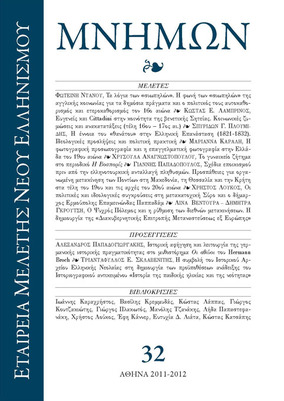Ναυπήγηση και συνεταιριστική διαχείριση (συμπλοιοκτησία) εμπορικών ιστιοφόρων στην Ερμούπολη τον 19ο αιώνα
Part of : Μνήμων ; Vol.31, 2010, pages 85-114
Issue:
Pages:
85-114
Parallel Title:
Ship construction and partnership owning of merchant sailing ships in Hermoupolis during the 19th century
Section Title:
Articles
Author:
Abstract:
Hermoupolis was a major maritime and shipbuilding centre in the eastern Mediterranean and the greatest shipping market of Greek-owned merchant marine during the 19th century. The aim of this paper is to present the main practises of building and partnership-owning of sailing ships in the shipping and shipbuilding market of Hermoupolis in the above mentioned period. These practises are traced through the examples of three ships built in Hermoupolis in 1838, while additional archival documentation is provided for comparison and further understanding.As far as partnership practises are concerned, there were different levels of complexity in the terms of management of the ship enterprise, which depended on the type of relationship between the partners (e.g. whether there were parental relationships between them or according to the share each of them possessed). The manifold role of the captain, as partner and at the same time manager and representative of the ship enterprise, was crucial for the profitability of the partnership, and the importance of his role was duly acknowledged by the rest of the partners.The examination of the three cases of ship construction and partnership-owning in Hermoupolis reveals the changes in the maritime business context after 1830 when compared to the pre-revolutionary practices of the Greek-owned merchant marine. The transition to the ship as a mere cargo carrier exclusively dependent on freight rates called for further rationalisation of cost administration, mainly reflected on crew management and the ways of payment. Ship-owners insistently tried to cut down crew numbers to the minimum necessary, while the system of payment with shares, which predominated before 1821, was replaced by a monthly salary. Both these modifications bespeak of the further integration of sea labour into the mechanisms of 19th century industrial capitalism. Regarding the building procedure, I studied the notarial acts drawn up between shipbuilders and owners concerning the construction of vessels, as well as other necessary agreements, like those made for the purchase of timber or the manufacturing of the metal components of ships. The data provide useful information about the time and cost required for the construction of sailing vessels and the ways of payment, along with details about the delivery of a ship to the owners, like the accompanying inventory including all her equipment.
Subject:
Subject (LC):




